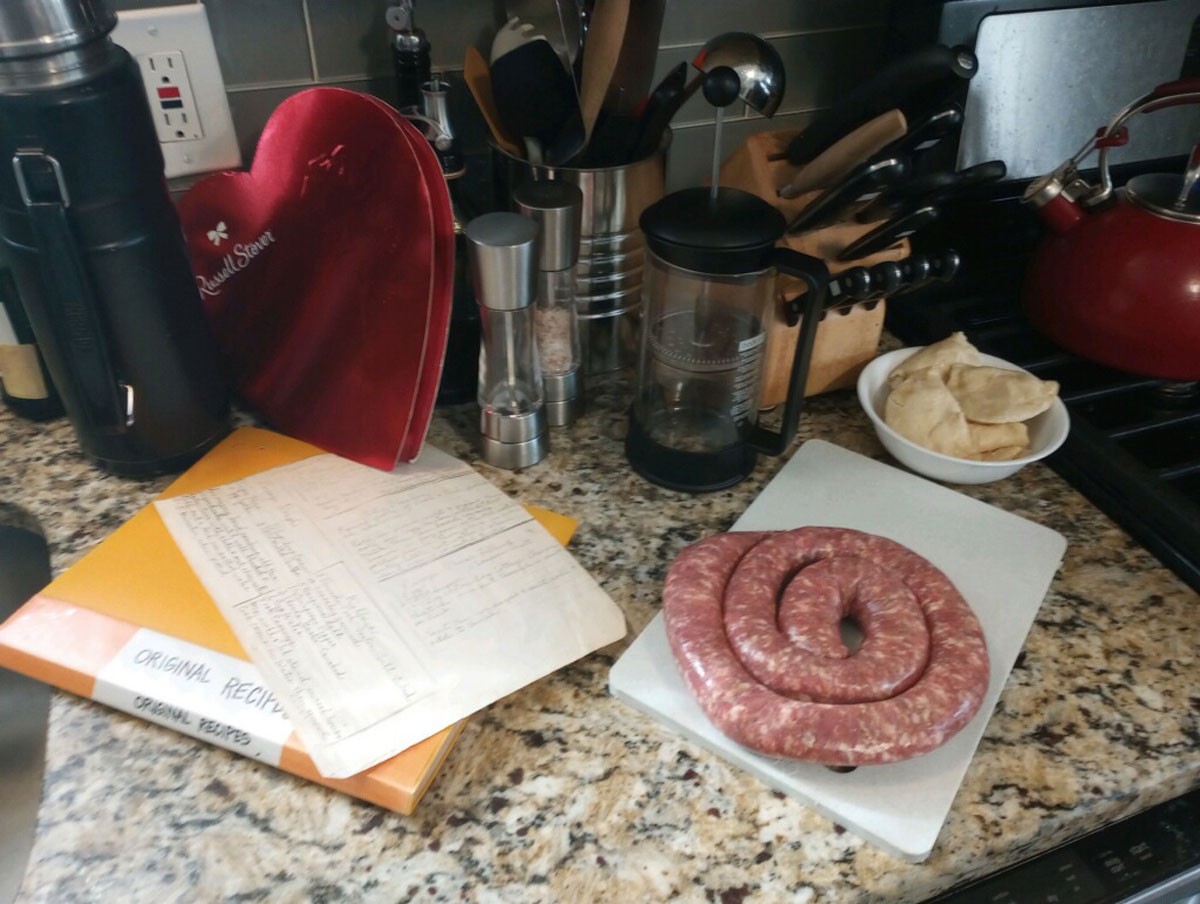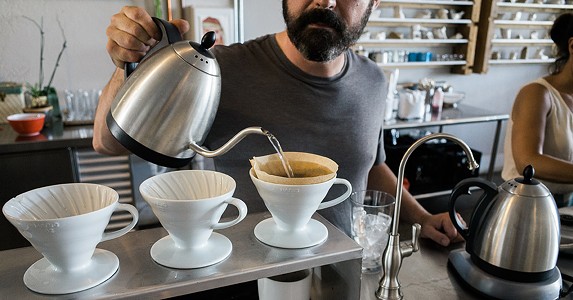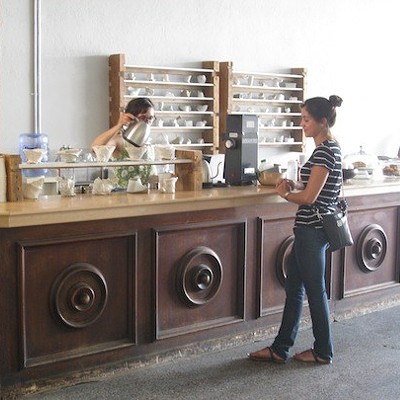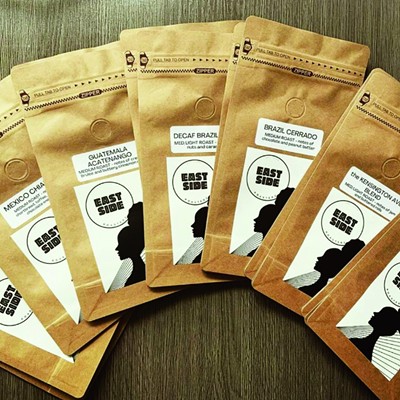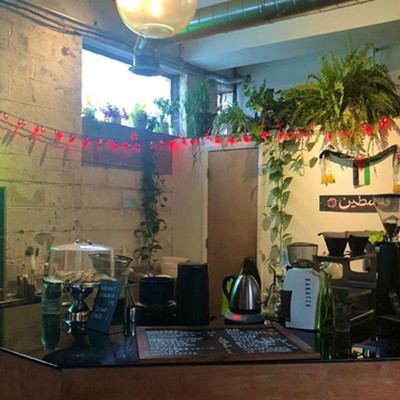Someone I loved and lost about a year ago put together a binder of my family’s old recipes for me. It doubles as a de facto scrapbook these days, its pages filled with memories I can taste. In it, there’s a sloppy joe recipe dating back to my Uncle Harry’s days in the Navy, when he served them up to ill-fated shipmates while stationed at Pearl Harbor, before and after that infamous December day in 1941. On another leaf, a seven-item list of the ordinary grocery store ingredients required to render my Aunt Mary’s irresistible salad dressing always leaves me laughing over restaurant customers I fended off in Phoenix through years begging me for them. I’d offer six for free, and the difference-maker seventh for a C-note. Oh, if they only knew. And reading between lines of now-faded, hand-written pierogi-making instructions, I make mental note of my grandmother’s very vocal insistence that properly-sized circles of pierogi dough are best cut by empty Maxwell House coffee cans. To this day, I scoff at seeing smaller scale models as authentically old school. To hear Grandma tell it, fist-sized pierogi set the standard. So it goes in my world. Further, walleye done right should always be fried in Stroh’s beer batter and eaten with Open Pit barbecue sauce, and sour cream is the proper finishing garnish for any good bowl of soup. Where simpler pleasures are concerned, nothing beats a plate of hot cottage cheese and noodles, kishka with scrambled eggs and ketchup, or a thick hunk of liver sausage with sliced raw onion, slathered with French’s mustard on good rye bread.
If you’re suddenly concerned that I may have just disqualified myself as someone who can speak credibly on the subject of “cuisine,” don’t be. It’s just that what’s going to be said here isn’t about fancy food anymore than I am or you are at heart.
This is simply the food story of us.
In the beginning…
As a species, I don’t think our love affair with food started as a raw movement. While I’m sure our hunter-gatherer ancestors relished eating everything they could find, I’m guessing the harnessing of fire struck the first gastronomic thunderclap in human evolution. Through captive flame, primordial man procured not only game-changing creature comforts of warmth and protection, but burning embers to boot. Probably not many campfires later, cave dwellers got lit up with another bolt of revelatory lightning or two. Maybe it happened by accident: a case of pre-Neanderthals in protein-induced comas leaving some carcass-tartare leftovers close enough to the coals overnight to smell like a good steak come morning. Once man discovered the magic of animal flesh meeting flame, the dawning of foodie pre-history had happened. It’s also my theory that lighting farts became a thing shortly thereafter, when close quarters, meat methane-passing became an attention-getting gas around the communal pyre.
But seriously, folks, as humankind made the civilizational turn from foraging to farming, the age of comfort foods (and basic adult beverages) dawned. From Babylonian to Biblical records, bread and wine were notably high on those lists. Leaps-and-bounds food preparation progress followed. History teaches us that foodstuffs like butter and popcorn were staples in Mesoamerica, predating their pairing in 20th century movie theaters by nearly as much time as it took modern man to reclaim his affinity for toothsome pleasures like smoked fish and dehydrated beef (“jerky”) through preservation processes our forebears innovated to provide themselves such proteins in the pre-Costco period. During the Middle Ages, otherwise uneducated serfs slaving away in castle kitchens somewhere in southern France figured out how to keep cooked poultry in its own fat during pre-refrigeration days. By the French revolution, culinary technique in France became so refined that julienne fried potatoes were named after it. America’s fast food hard-chargers, pirates, and royalty — Colonel Sanders, Ray Kroc, Burger King, and the like — ascended several billion happy customers later. The rest, as they say, is history, albeit highly abridged here, past to present.
Current events — dining market adjustments or crash?
Blithe backstory aside, commercial epicurean society finds itself in some sobering circumstances these days. Coming completely current, the jury’s out right now on how much of an extinction event COVID-19 may amount to in the restaurant sphere as a whole. There’s certainly been some seismic shifting in how a hungry world of consumers are choosing to eat “out.” Eating in’s not the norm anymore. Pandemic panic and/or precautions hit sit-down dining like a killer meteor, and the fallout’s still raining down hard, especially on the proprietary landscape. Remote work has devastated business lunch rushes which daytime restaurant owners and their service staffs could once count on. Meal delivery services may be booming and replacing a portion of jobs lost to food and beverage workers, but these deliver food from the fast and quick-serve sectors much more so than the dine-in segment of the industry. From full-service, family restaurants to fine dining, the attrition’s been atrocious. So are the prices food businesses are charging. Whether forced to by their own skyrocketing purchasing costs, an ongoing epidemic of profiteering greed that COVID triggered in some unscrupulous corners of both wholesale and retail food commerce, or a likely combination of such factors in many cases, fast food menus are pushing limits even the convenience-focused customer may prove willing to pay a premium for at this point, while the dine-in demographic is being asked to accept dinner pricing for lunch and pork chops for what most steakhouses were charging for prime rib and porterhouses at the end of 2020, when all this hard-to swallow food inflation started.
And on the home-cooking front, it’s time to call out some businesses, for better or worse
It’s rare that I buy retail beef these days. Save for Cattleman’s in Taylor and Value Center Marketplace in southeast Livonia, I’ve found too little in the way of value perception in the meat and seafood department during my year-and-a-half exploration of grocery shopping options in metro Detroit. And it’s more and more seldom that my going to market experiences satisfy overall. Kudos to places like Trader Joe’s and Busch’s for the premiums they obviously place on customer service. Love Trader Joe’s for their company brand gourmet goods (olives, pesto, gnocchi, edamame, etc.), bread quality, and seemingly opening-up another check-out line with a smiling, content team member any time I find myself waiting more than a minute or two there in line. Busch’s staff step up, too, in that regard, from the deli and meat and seafood crews, to managers constantly monitoring and manning the check-out lines and customer service desk. While I’ve only managed a small sampling of what higher-end markets like Nino Salvaggio’s, Westborn, and Joe’s offer, I will say I’ve always gotten what I’ve been willing to pay for from them: pristinely fresh and picture perfect produce, primarily, along with ultra-fresh seafood (you, too, Busch’s).
Perchance you’re noticing the Kroger brand conspicuously absent from my complimentary list. What can I say? Don’t get me started. In my experience, this company has clearly abdicated virtually all the duties to customer service I’ve just commended a number of their competitors for. And that’s probably because monster conglomerate Kroger Corporation feels no real pressure to perform out of fear of losing sufficient market share to have to actually make any effort to even appear to give a shit about the food-buying public they treat like human chattel here in their Michigan market. I say that and make that distinction because as a loyal Fry’s shopper for decades in Arizona (that’s the name the Kroger brand conducts business under there), the stores are better stocked, better staffed, and better maintained generally than the condition I find them in this state, for whatever reason(s). And this isn’t some COVID thing they can blame. I left Arizona well into 2022. No, there must be other reasons for Kroger’s Mitten State mess: the constant logjams of long, self-service lines attended by outnumbered and demoralized staffers left to manage too many customers struggling with self-checkout at terminals that can’t accept cash, give the correct change when they do, or even price things correctly, and just aren’t open in numbers sufficient to handle their business flow. It’s a sad shopping experience most often at any Kroger I visit around town. Between staffers’ broken-down morale and the run-around it always seems to require to ring-your-own and bag-your-own groceries, it’s usually a shitshow, if truth be told. No wonder Kroger’s ad campaign is a cartoon. I doubt they could find enough real people — either customers or employees — to film a live commercial that would come across as an endorsement.
OK, where is all this leading?
As to our future forays into life’s eating adventure, who knows where we’re headed? I’m not some Nostradumbass trying to predict what’s coming next or where this inflation that’s blowing-up everybody’s food spending budget will end. I’m just a guy observing the same food trends you are, filling my grocery cart everywhere you do, and hoping the current concerning trajectories touched on here level off for everyone’s sake. I have endless empathy and deep concern for full-service restaurants that are struggling mightily in specific; mom and pop operators who’ve always had to walk tightrope-thin profit margins, and a food service industry in general that feels a need to charge more and more for less and less. On the home front, my heart goes out to hard working people in families who have to swim against these rising tides of food that’s getting far less affordable. Doing my professional duty, I see startling numbers of fairly-empty dining rooms. In businesses that are all about putting butts in seats, that’s worrisome. On my own dime, I spend ample time standing in grocery store lines, looking around and listening. In places where people have no problem paying four bucks a pound for jalapeño peppers, it’s a different reality. In dollar stores where few things actually cost that little anymore, I see another story: moms and dads with small baskets half-filled with cans of refried beans and 10-packs of corn tortillas, eyeing every next ring of the register, and trying not to make too much of having to say no to their little ones’ wants for some candy treat things are just too close to cover that day.
Now, back to that old recipe binder of mine
What food is costing us these days takes me back to what I’ve always done during times when either money’s been tight and I’ve had more mouths to feed than just my own, or I just hungered for a little comfort: some real, simple sustenance for body and soul. I head into the kitchen where I can always whip up a recipe for that, whether I make something that makes me remember or helps me forget.
For all the life’s choices I could second-guess, I’ve not one regret over becoming a cook. It’s done me and mine nothing but good, while serving and satisfying others. A meal made with social intention then shared is such a genuinely human exchange. It’s thoughtful gift-giving as palpable as anything could be; something we smell and taste that truly touches. Making something for others to eat is a most generous use of our time. Raised by three women who helped mother me while constantly wearing kitchen aprons, I learned their love language of food. Virtually everything I cut my teeth on as a boy was served homemade, heartfelt, and homespun. I watched my grandmother make regular hot lunches for our mailman during the Dearborn winters of my boyhood. Whenever company came to our door for whatever reasons, expected or not, feasts awaited them, either at the ready or readily prepared at a moment’s notice. My Aunts Helen and Mary baked constantly, “in case someone comes over,” they’d say, keeping up constant provisions of pound cakes and pies to feed small armies on any contingencies or impromptu occasions. Some of our food hospitality embarrassed me back then. Blushing boy me wondered: Who eats this stuff but us? Pig’s feet gelatin? Duck blood soup? Reflected in our plates, we appeared way too ethnic for my tastes. Sometimes while sitting at our tables, I couldn’t wait to grow up and get out of the crazy international house of Polish potato pancakes I was born into.
For all the life’s choices I could second-guess, I’ve not one regret over becoming a cook. It’s done me and mine nothing but good, while serving and satisfying others.
tweet this
Then, a funny thing happened. I grew out of that childishness shortly after running off out West to find myself working in the restaurant business. There, I found beet soup on fine dining menus, fresh sausage being made by artisan suppliers, and things not far from Grandma’s boiled and chopped chicken livers playing well to ’80s-’90s foodie crowds in pate form. From that point of revelation, backwater perceptions of my food heritage pivoted into something I took new stock in personally and professionally. Ever since, my cooking life’s been an ongoing exercise in both purist preservation of my family cookbook, and rewriting some recipes to suit tastes that have changed over time in me, my family and friends, and the clients and customers I’ve cooked for and served over the years.
The story of us — each and all — is a never-ending tale rich in character development that takes its turns along with the times we’re given to live in and learn from.
When I was a child, I thought as a child, and ate as a child while thinking my family food story was something peculiar that I’d do well to keep to myself when I got older. Once I became a man, I put away such childish things the minute it occurred to me how cool my family cookbook actually was. And I’ve been cooking from it ever since; adding pureed chipotle peppers and grated asiago to Grandma’s pierogi filling sometimes, and just eating her potato and fried onion version at others. I’m glad I’ve carried on our family food traditions that way and started new ones with only minor variations to them (my kids love those Polish-New Mexican pierogi).
To those of you reading this:
If you’ve some food legacy of your own you’d like to share, reach out to us at [email protected]. And if you’re some grocer or other food vendor who feels you have something to offer our food content readers, do the same. If there’s something newsworthy or otherwise noteworthy you can indeed contribute to the conversation, we can talk about it in either in my weekly Chowhound column or, perhaps, feature you in some future piece we’ll put together that will do metro Detroit some good on that front. We’re all about that. We may be “alternative,” but we’re not aloof to addressing collective needs of our community as a whole.
This food writer’s always ready to talk, willing to listen, and able to carry on conversations that, taken together, can contribute to telling more of the food story of us. Chime in. Add to it. And stay tuned.
Subscribe to Metro Times newsletters.
Follow us: Google News | NewsBreak | Reddit | Instagram | Facebook | Twitter

